Key takeaways:
- DIY surveillance offers control, flexibility, and cost-saving benefits by allowing customization to fit individual needs.
- Essential equipment includes quality cameras, DVR/NVR recorders, and proper mounting accessories to ensure effective security coverage.
- Choosing the right cameras based on environment, resolution, and features like night vision is crucial for effective monitoring.
- Maintaining and upgrading both hardware and software is key to maximizing the effectiveness and reliability of your surveillance system.
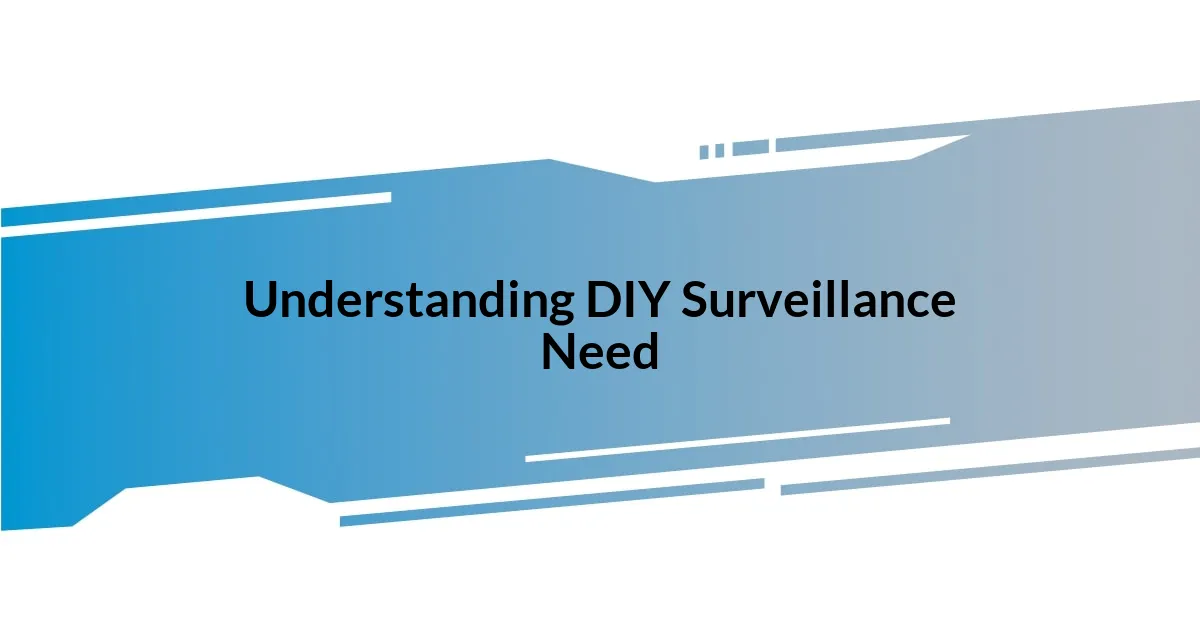
Understanding DIY Surveillance Need
When I first considered setting up a DIY surveillance system, I realized how much control it could give me over my home’s security. It wasn’t just about watching over my property; it was the peace of mind that I craved, knowing I could access footage anytime, anywhere. Have you ever felt anxious when you’re away from home? I certainly have, and that’s where my journey began.
One compelling reason to dive into DIY surveillance is the flexibility it offers. You can customize the setup to fit your unique needs, whether you want to monitor a specific entry point or keep an eye on your pets while you’re at work. I remember installing a camera to watch my garden, where I had been noticing some suspicious activity. It was empowering to know that I could easily tailor my system rather than rely on a one-size-fits-all solution.
Budget constraints also play a significant role in the decision to opt for a DIY approach. I’ve found that professional installations can be quite costly, and often include monthly fees for monitoring services. Why not harness the technology yourself and save that money for something else, like enhancing your garden or treating yourself? Settling for less while tapping into existing skills can truly resonate with those aiming for both security and financial prudence.
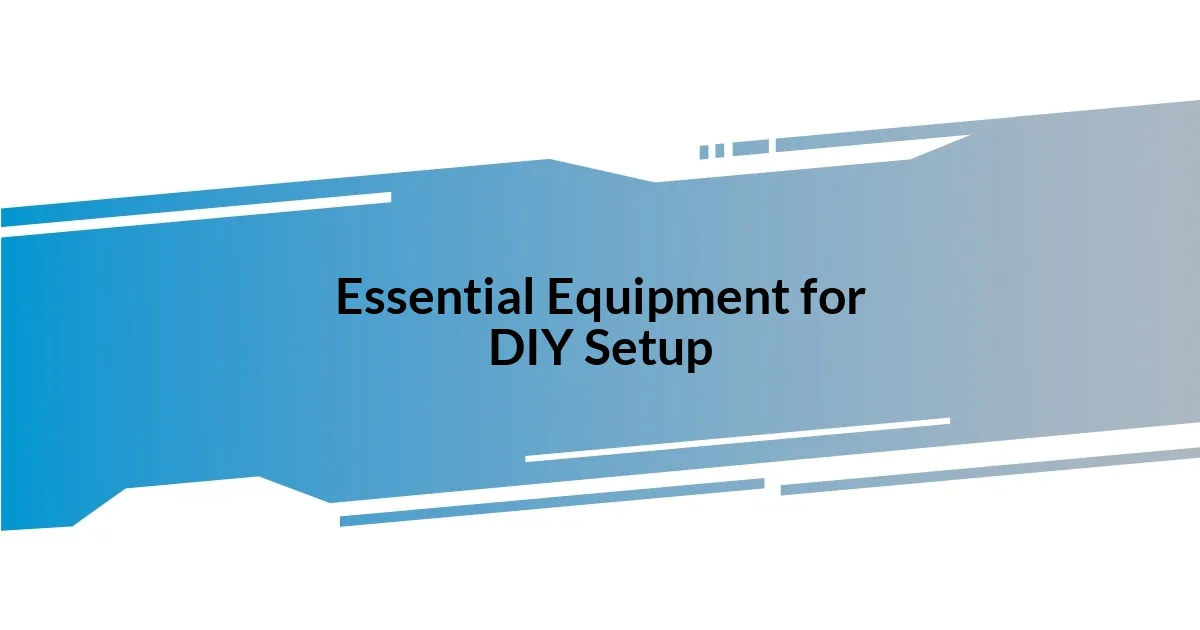
Essential Equipment for DIY Setup
Setting up a DIY surveillance system requires a solid foundation of essential equipment. From my experience, investing in the right tools can make all the difference. For starters, think about quality cameras. I remember the first time I installed my outdoor camera; the clarity was astonishing, and being able to spot every detail gave me an incredible sense of control over my domain.
Here’s a quick list of must-have equipment for your DIY setup:
- Cameras: Choose between wired and wireless options based on your needs. I opted for wireless for its flexibility.
- DVR/NVR Recorder: This device stores the footage. I learned that having enough storage space is crucial for reviewing past events.
- Mounting Accessories: Proper mounts ensure your cameras are stable and positioned well. I’ve had to adjust mine a few times to get the perfect angle.
- Cables: If you use wired cameras, high-quality cables prevent signal loss.
- Power Supply: Reliable power sources are essential, whether for plug-ins or batteries.
- Monitor/Smartphone App: For easy access to the footage, use a dedicated monitor or a user-friendly app. It’s so comforting to check in on my home while I’m out and about.
With these essentials in hand, you’ll be well on your way to crafting a surveillance system tailored to your unique needs and lifestyle.
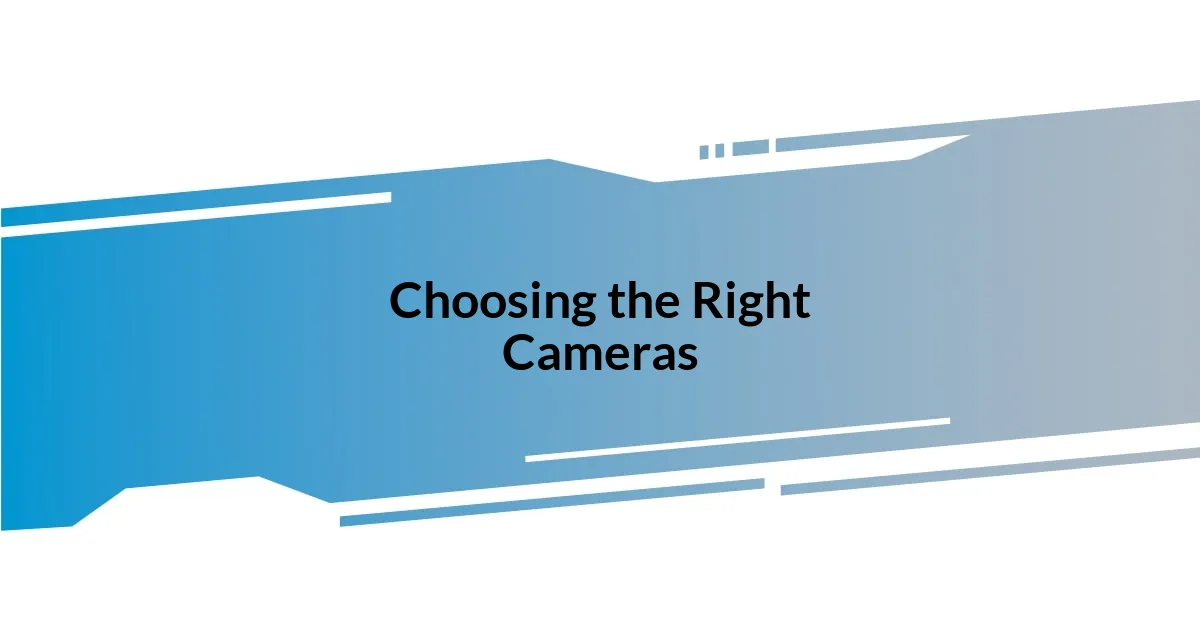
Choosing the Right Cameras
When it comes to choosing the right cameras for your DIY surveillance system, several factors can influence your decision. I once spent hours researching types of cameras, realizing that not all are created equal. For instance, indoor cameras often differ significantly from outdoor ones, and I learned the hard way that a high-quality outdoor camera can withstand harsh weather. Have you considered the environment where you’ll place your cameras? I know I always factor in things like weather conditions and lighting before making my choices.
Another key consideration is the resolution of the cameras. In my experience, investing in higher resolution ensures clear images, which is crucial when you need to identify faces or license plates. For example, I opted for a 4K camera for my front door, which has made all the difference in capturing important details. Plus, many cameras come with features like night vision or motion detection, which I found invaluable for enhancing security during those late-night hours.
So, how do you weigh these options? Here’s a simple comparison table that can guide your decisions on camera types:
| Camera Type | Key Features |
|---|---|
| Indoor | Typically lower cost; great for monitoring pets or kids |
| Outdoor | Weatherproof, night vision, and expansive field of view |
| Wireless | Easy installation, flexible placement, but may require battery maintenance |
| Wired | Stable connection, no battery issues, but requires installation effort |
Reflecting on my setup journey, I vividly remember the excitement of finding the perfect camera that met my needs. Choosing the right cameras really made a significant impact on my home security, and I encourage you to think about your specific requirements as you make this important decision.
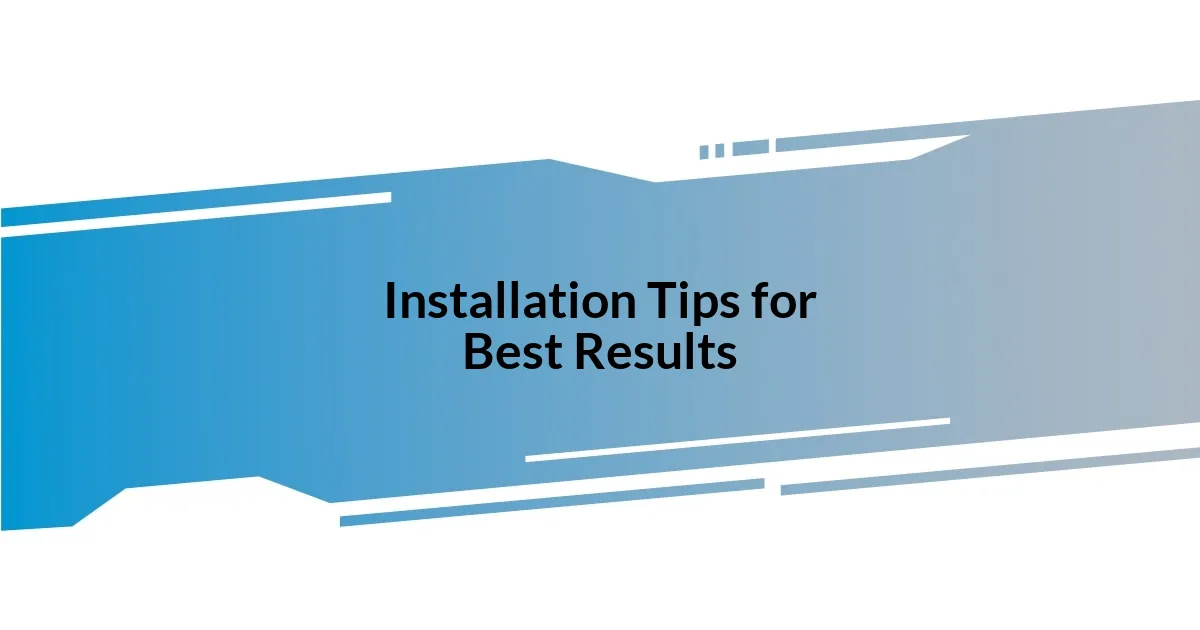
Installation Tips for Best Results
Once you have your equipment, proper placement is crucial. I found that spending time to scout your property pays off immensely. For instance, when I first installed my cameras, I placed my driveway cam too close to the house, which limited the view. After some trial and error, I moved it further out, and the adjustment provided a much broader perspective. Have you thought about where vulnerable entry points are? Don’t underestimate the importance of angles; even a slight shift can enhance visibility significantly.
Wiring can be a headache, but it doesn’t have to be! I learned early on that organizing and securing cables not only boosts the aesthetic but also prevents them from being tampered with. I remember using clips to neatly route the cables along my walls, which not only looked professional but also kept them safe from potential damage. If you’re going wireless, ensure you set up your cameras within good Wi-Fi range; I had to reposition one just to stop the annoying drop in connection every time a car passed by.
Finally, don’t skip on testing your system. After everything was installed, I took a moment to review the live feeds and even recorded a few sessions. The peace of mind that came from ensuring every camera was functioning well was truly worth it. I recall feeling a rush of satisfaction watching the footage in real-time, knowing my home was now a fortress of security. Have you planned for regular system checks? It’s a good habit to get into!
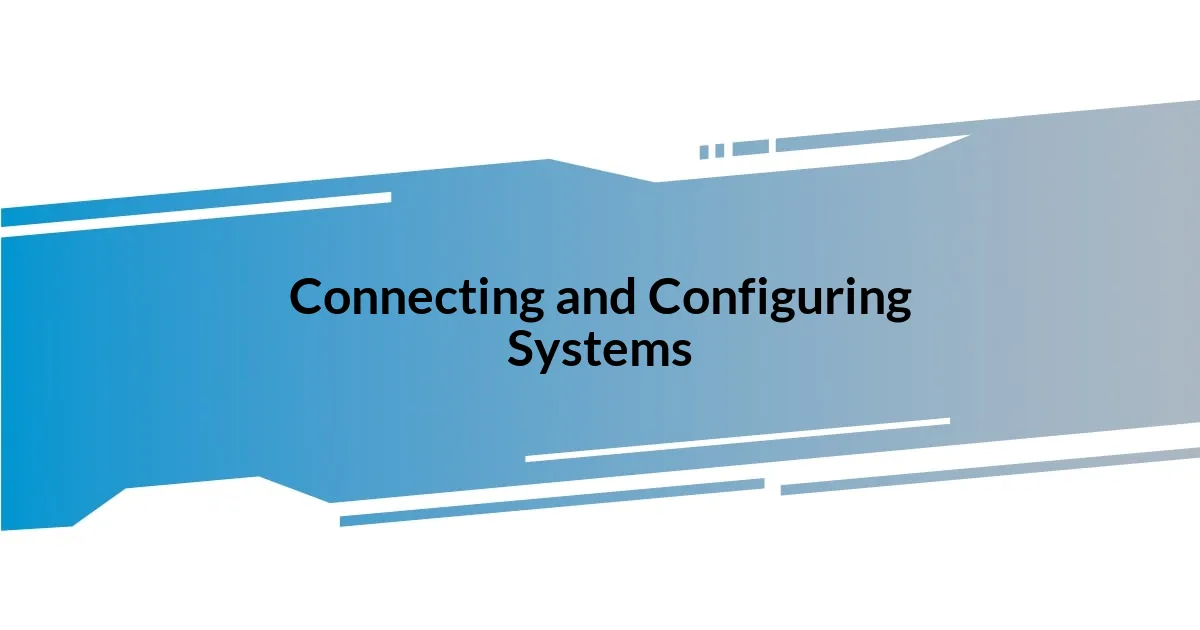
Connecting and Configuring Systems
Connecting your cameras and configuring your surveillance system can feel overwhelming, but I’ve found it to be one of the most rewarding parts of the setup. I remember when I first connected mine; the sense of accomplishment was palpable, especially when everything clicked into place. Have you ever experienced that moment of clarity when technology just works? I made sure to follow the manufacturer’s instructions closely, which saved me from a potential headache later on.
When it comes to configuring your settings, think about what matters most for your security needs. I experimented with different motion detection sensitivity levels after my camera kept sending alerts every time a leaf blew by! Adjusting these settings helped reduce false alarms significantly. In my case, being able to capture crucial moments without unnecessary distractions was a game-changer, and I’d encourage you to find that balance in your own setup.
Don’t overlook the importance of software updates as well. I learned the hard way that keeping your camera firmware up-to-date is crucial for optimal performance. After a few weeks of using an outdated app, I missed a couple of alerts that could’ve been captured with the improved features in the update! Have you considered setting reminders for regular updates? It’s a simple step that can enhance your system’s reliability and security, making it truly worth the effort in the long run.
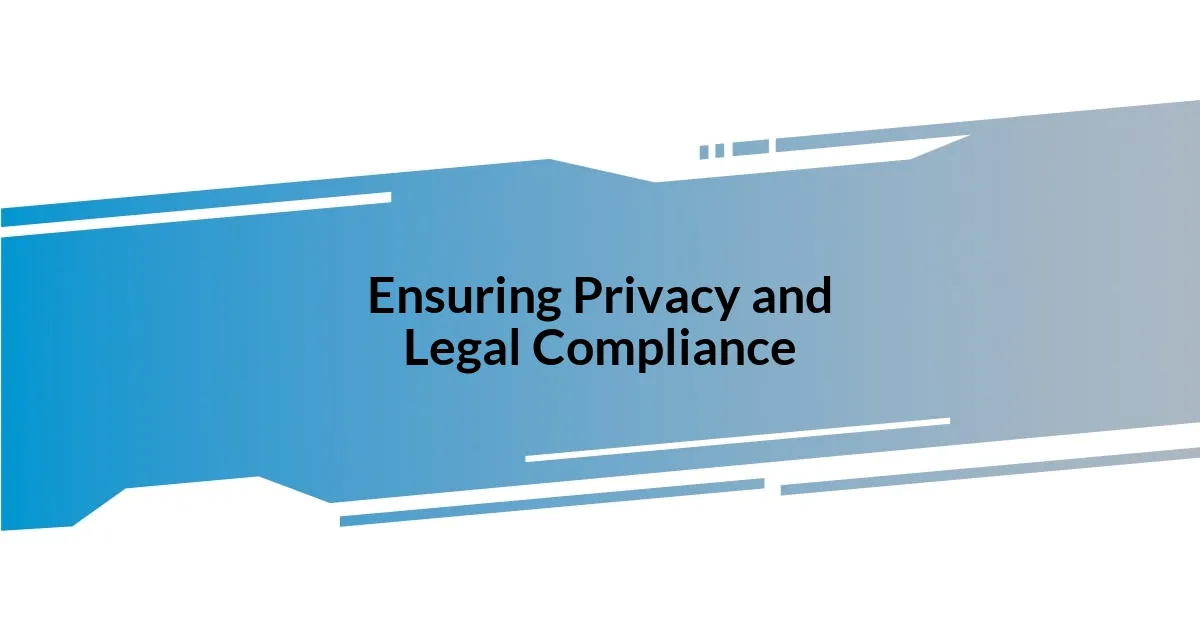
Ensuring Privacy and Legal Compliance
When setting up DIY surveillance, understanding privacy regulations is essential. I once underestimated the implications of recording in my backyard, which also bordered a public area. Realizing that I could inadvertently capture my neighbors sparked a real concern for their privacy and led me to research local laws. Have you checked the regulations in your area? Being informed not only protects others but also shields you from potential legal complications.
Consent is another facet that can be overlooked. I remember the awkward conversation I had with a close friend after installing cameras that faced shared areas. Ensuring everyone was on board made a world of difference and fostered a sense of trust. Have you discussed your system with family and friends? Clear communication helps avoid misunderstandings and creates a secure and comfortable environment.
Finally, consider where your footage is stored. I learned the importance of cloud storage for accessibility and security—no one wants to find out their valuable recordings are lost forever. I’ve used password protection to add another layer of security, which gives me peace of mind. How do you plan to safeguard your recordings? Being proactive about your surveillance data ensures it remains private and protected.
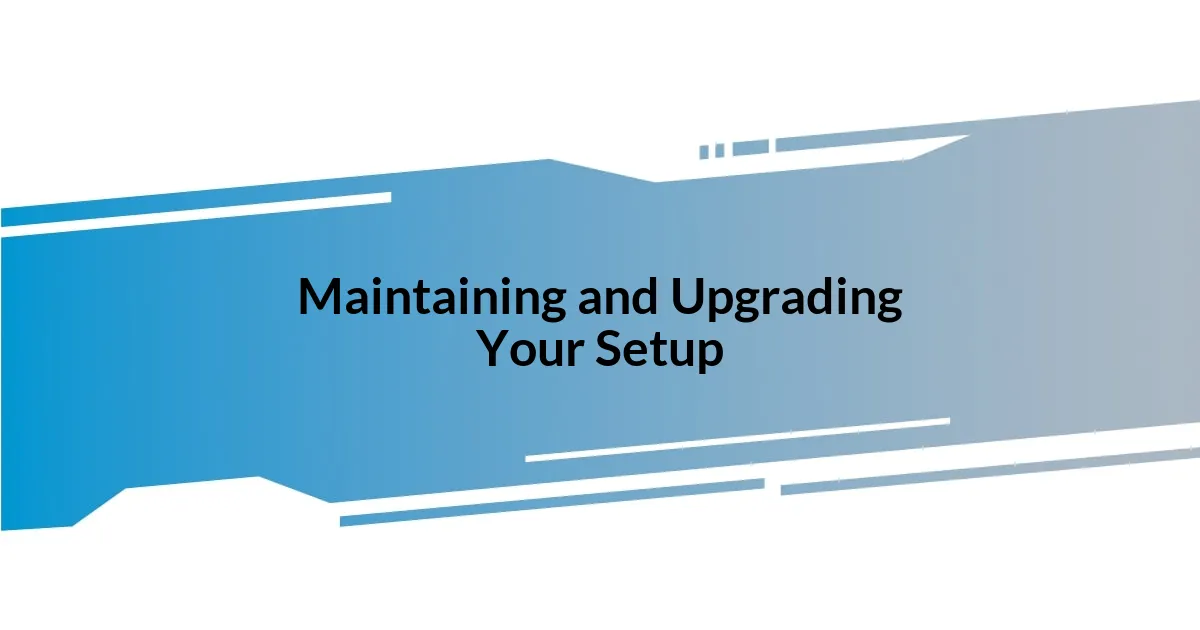
Maintaining and Upgrading Your Setup
Maintaining your DIY surveillance setup isn’t just a checklist task; it’s an ongoing commitment to ensuring your security remains robust. I recall last summer when I dedicated a weekend to deep-cleaning my cameras. I didn’t realize how much debris had accumulated, which can really obscure the view. How often do you take the time to check your equipment physically? A quick routine inspection can save you from missing critical footage during an event.
Upgrading your equipment is another key aspect to consider. After a year of use, I decided to swap out my old camera for a newer model with advanced night vision capabilities. The difference was incredible! I often revisit my choices to ensure I’m not falling behind on the latest technology. Have you looked into the features available that could enhance your setup? Staying updated gives me the confidence that I’m prepared for whatever may happen.
Finally, don’t forget about software enhancements. I learned the value of extra features like person detection after trying them out on my system. It made managing alerts so much easier! Implementing such upgrades wasn’t a hassle; it became an exciting way to optimize my setup. Have you explored what updates your system can accommodate? Embracing these advancements can lead to significant enhancements in both performance and peace of mind.